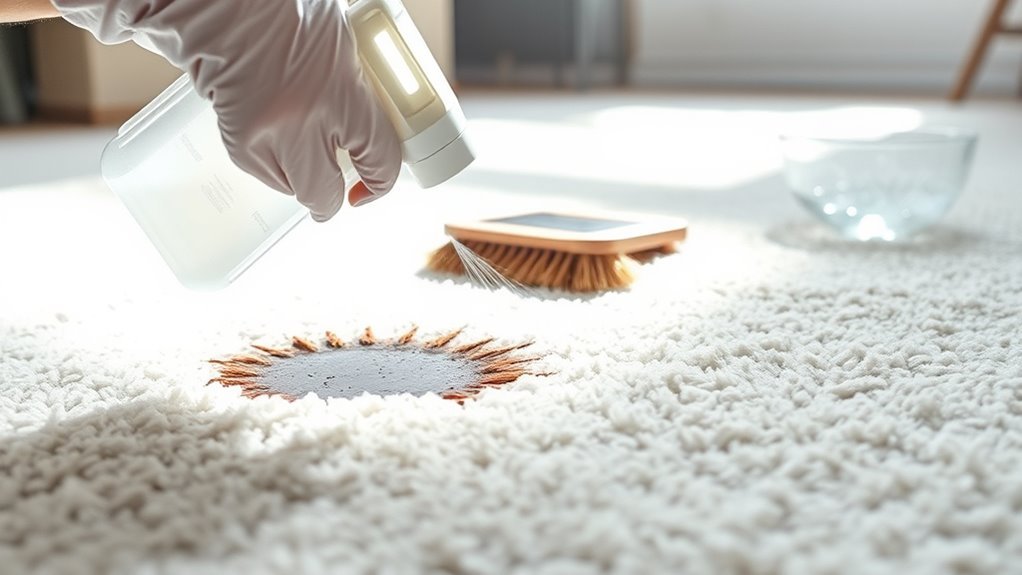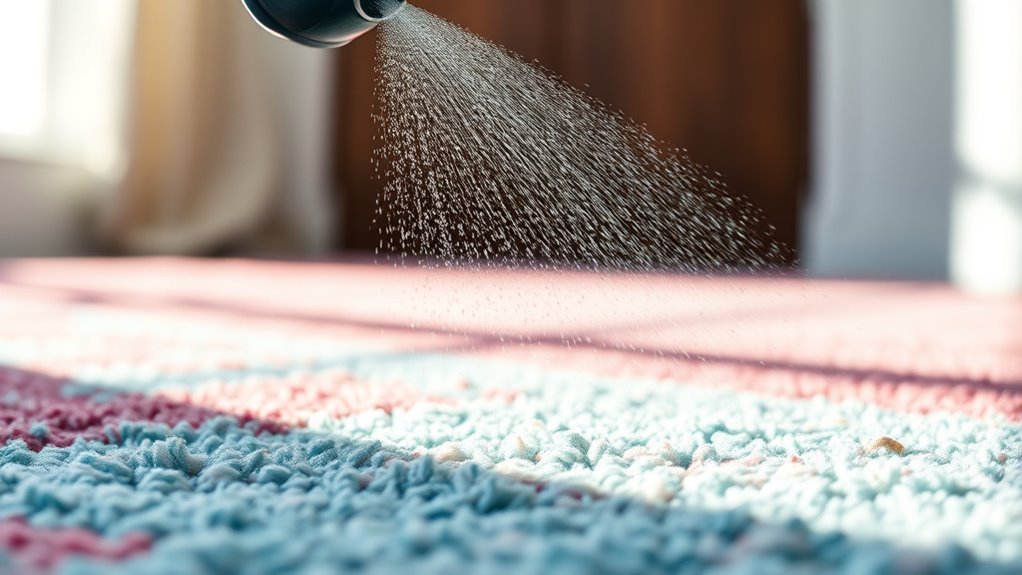Removing Germs Stains From Carpets
To remove germ stains from your carpet, first identify the type of stain—whether biological like blood or fungal like mold. Use gloves, a vacuum with HEPA filtration, and an enzymatic cleaner or disinfectant made for carpets. Blot the stain gently, apply the solution, work it in with a soft brush, then rinse and dry thoroughly. Natural options like vinegar and tea tree oil are also effective. Following these steps keeps your carpet germ-free, and there’s more you can do to maintain lasting cleanliness.
Identifying Different Types of Germ Stains

When you’re dealing with germ stains on carpets, the first step is knowing what you’re up against. Germ stain identification is essential because different stains require specific carpet cleaning techniques. For instance, biological stains like blood, urine, or vomit carry bacteria and viruses that need targeted treatment. Mold and mildew stains, on the other hand, indicate fungal presence, demanding different cleaning solutions. You should also recognize stains from food or drink spills, which may harbor germs but respond well to standard disinfectants. Accurate identification helps you choose the most effective method to eradicate germs without damaging your carpet’s fibers. By mastering germ stain identification, you gain control over the cleaning process, ensuring a healthier, freer living space that’s truly clean and safe. Recognizing mold stain characteristics can be particularly helpful in distinguishing fungal stains that require specialized cleaning methods.
Essential Tools and Cleaning Supplies
A variety of essential tools and cleaning supplies are crucial for effectively removing germ stains from carpets. You’ll need a sturdy vacuum cleaner with HEPA filtration to remove loose dirt and germs before treatment. Keep on hand microfiber cloths and soft-bristle brushes for targeted cleaning without damaging fibers. Use enzymatic cleaners or disinfectants designed for carpets to break down organic stains and kill germs efficiently. Gloves protect your hands, ensuring safety during the process. Having a spray bottle lets you apply cleaning solutions evenly, enhancing cleaning techniques. Additionally, carpet protectors or sealants can be applied post-cleaning for stain prevention, extending your carpet’s freshness. Equipping yourself with these tools empowers you to maintain a clean, germ-free carpet environment confidently and independently. Regularly vacuuming, especially with a vacuum designed for pet hair, helps reduce the buildup of pet dander and germs trapped in carpet fibers.
Step-by-Step Stain Removal Process

To effectively remove germ stains from your carpet, follow these five critical steps in sequence. First, blot the stain gently with a clean cloth to absorb excess moisture, avoiding rubbing which can spread germs. Second, apply a disinfectant solution recommended for carpets, ensuring it aligns with your carpet cleaning methods. Third, use a soft brush to work the solution into the fibers, employing proven stain removal techniques. Fourth, let the solution sit for the instructed time to break down germs and stains thoroughly. Finally, rinse the area with clean water and blot dry to remove residues. By adhering to this precise process, you maintain a germ-free carpet while preserving its integrity and ensuring lasting cleanliness without compromising your freedom to enjoy your space. It is also important to test cleaning solutions on a hidden area first to protect your carpet’s fabric integrity.
Natural Remedies for Germ-Free Carpets
Following the step-by-step stain removal process guarantees your carpet is clean and disinfected, but you might also want to contemplate natural remedies to maintain a germ-free environment without harsh chemicals. Using natural disinfectants like white vinegar or tea tree oil offers powerful antimicrobial effects while being safe for your home and the planet. These eco friendly options effectively reduce germs without leaving toxic residues. Simply mix vinegar with water in a spray bottle or add a few drops of tea tree oil to your cleaning solution. Both methods help neutralize bacteria and fungi, promoting a healthier space. By choosing these natural disinfectants, you not only protect your family but also support sustainable living practices, ensuring your carpet remains fresh and safe without compromising your freedom from harmful chemicals. Additionally, regular cleaning of high-touch surfaces in your home complements these natural methods to help maintain overall cleanliness and reduce germs. This combination of approaches is key to keeping a truly germ-free environment.
Preventative Measures to Keep Carpets Clean

Although regular cleaning is essential, preventing dirt and germs from settling in your carpet is the most effective way to maintain its cleanliness. You can take proactive steps in carpet maintenance to minimize stains and microbial buildup. Start by placing doormats at entrances to reduce tracked-in dirt. Encourage a no-shoes policy indoors to limit grime. Regularly vacuum high-traffic areas to prevent soil from embedding deep in fibers. Address spills immediately with appropriate stain prevention techniques—blot, don’t rub, to avoid spreading contaminants. Consider professional deep cleaning annually to eliminate hidden germs. By implementing these preventative measures, you not only extend your carpet’s lifespan but also create a healthier environment that supports your freedom from constant worry about stains and germs. A quick pass with a vacuum cleaner regularly helps lift dirt and debris before it settles deep into carpet fibers.
Frequently Asked Questions
Can Professional Carpet Cleaning Remove All Types of Germ Stains?
You might wonder if professional carpet cleaning can remove all types of germ stains. While it’s highly effective at germ removal, no method guarantees 100% elimination of every germ or stain. Professionals use advanced techniques that markedly reduce bacteria and allergens, restoring your carpet’s cleanliness and safety. However, some deeply embedded or old stains may require multiple treatments. Trusting experts gives you freedom from worry and a healthier living space.
How Often Should I Deep Clean My Carpet to Prevent Germ Buildup?
You should schedule deep carpet cleaning every 12 to 18 months to maintain ideal carpet maintenance and prevent germ buildup. However, if you have pets, kids, or allergies, increasing cleaning frequency to every 6 to 12 months is wise. Regular vacuuming complements deep cleaning by reducing surface dirt. Staying consistent with this schedule helps you enjoy a healthier, fresher living space without sacrificing your freedom to live comfortably.
Are There Specific Carpet Materials More Resistant to Germ Stains?
You’ll find that nylon carpets are generally more resistant to germ stains due to their durable, synthetic fibers that repel moisture and dirt better than others. Wool carpets, while luxurious and natural, tend to absorb stains and germs more readily because of their porous structure. So, if you want a carpet that’s easier to keep clean and free from germ buildup, nylon is usually the smarter choice for lasting freshness and freedom from frequent deep cleaning.
Can Germ Stains Cause Allergies or Health Issues?
Yes, germ stains can lead to allergy symptoms and health issues due to prolonged germ exposure. When germs accumulate, they can trigger reactions like sneezing, itching, or respiratory problems, especially if you’re sensitive or have existing allergies. It’s important to address these stains promptly to minimize your risk and maintain a healthier environment. Staying proactive helps you enjoy your space freely without worrying about hidden allergens affecting your well-being.
Is It Safe to Use Bleach on Carpets to Remove Germs?
Using bleach on carpets is like using a sledgehammer to crack a nut—it’s often too harsh and can damage fibers or discolor your carpet. For carpet safety, it’s better to choose bleach alternatives like enzyme-based cleaners or vinegar solutions. These options effectively kill germs without compromising your carpet’s integrity. You want to maintain a healthy environment while keeping your carpets looking fresh and intact, so opt for gentler, safer solutions.






